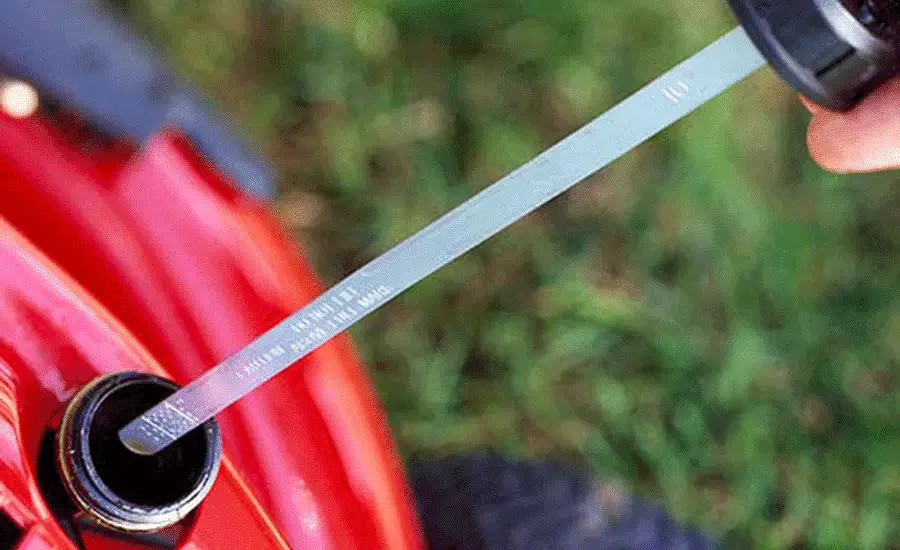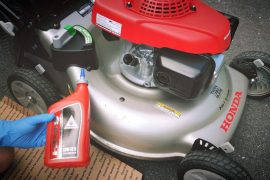A lawn mower is an incredibly convenient and efficient tool to keep your lawn well-groomed. There are a few things that need to be changed regularly, especially the oil. To keep the lawnmower engine in a healthy operating condition and extend its life, it’s critical to keep the oil at a sufficient level.
If you’re thinking about changing the oil of your lawn mower, you might be wondering: how much oil does a lawn mower need?
Don’t worry, we will discuss it in detail in this article.
So, stick with us!
In this content you’ll learn:
How Much Oil Does A Lawn Mower Take: Your Ultimate Guide
If the lawn mower’s oil level is incorrect, it can cause serious issues with your engine. Properly fueling the lawnmower is an important part of your lawn mower maintenance, so we’ll outline everything you need to know about fueling your mower.

The Oil Capacity Of Your Lawn Mower
The oil capacity of your lawn mower depends on the engine type or brand of the mower, as each one’s oil capacity will be different.
What we’ll be focusing on is the general guideline, based on the two types of lawn mowers. One is the walk-behind lawn mower, and the other is the riding lawn mower.
Walk-behind lawn mower:
The oil capacity for this one is usually 15oz or 18oz. The engine’s oil should be changed every 50 hours or once a year, whichever comes first.
Riding lawn mower:
The oil capacity of the riding lawn mower is usually 48 oz or 64 oz. The engine’s oil should be changed every 100 hours or once a year, whichever comes first.
Brand and engine-wise oil capacity
- Toro 6.5 hp (1900 cc) lawnmower – 16 Oz
- GCV 160/190 Honda Lawn Mower Engine – 18 Oz
- Craftsman 6.5 lawn mower – 20 Oz
- Troy Bilt TB230 – 20 Oz
- Lawn Boy 6.5 149 cc – 20 Oz
- Husqvarna Lawn mower engine – 20 Oz
- Tecumseh lawn mower – 19 Oz to 64Oz
- John Deere lawn mower – 48 Oz
- Briggs and Stratton Riding Mower engine – 64 Oz (Commercial engine, V-Twin), 48 Oz (Single cylinder, power built, professional series), 18 Oz (1000 series)
Lawn Mower Oil Type Recommendations
The temperature has a considerable impact on the oil’s performance. Certain oil types perform better at certain temperatures. So, it’s helpful to know which fuel should be paired with which temperature, in order to achieve the best performance. Here are some recommendations below:
- SAE 30– The most popular oil for small engines, which is usually used for warmer temperatures (4 C to 38 C or 40 F to 100 F).
- SAE 5W-30 – It works best at extremely low temperatures. Which is around 4 C to -29C (40 F to -20 F).
- Synthetic SAE 5W-30 – this actually provides the best protection at all temperatures (30 C to -29 C or 100 Ft below -20F), while also improving starting ability of the engine and lowering the oil consumption.
- SAE 10W-30 – With a wide temperature range (-18 C to 38 C or 0 F to 100 F), this oil also functions in cold weather. However, the cold weather may increase oil consumption.
- Vanguard 15W-50 – this comes in a variety of temperature ranges (-7 C to above 49 C or 20F to above 120 F) and is usually preferred for long-term use. For instance, it would be used for commercial lawn care or power washing.
How To Check The Oil Level Of Your Lawn Mower
- Remove the cap of the dipstick by turning the cap counterclockwise with some pressure.
- Remove the dipstick and clean it by using a clean cloth. This is important for getting an accurate reading.
- Make sure that the teeth on the cap fit with the grooves on the dipstick tube. Do this before reinstalling the dipstick.
- To reattach the dipstick cap, apply some pressure by twisting clockwise.
- Remove the cap and look at the oil level around the dipstick blade’s bottom.
The oil level should be in between the ‘full’ and ‘add’ mark – or in some cases, the Low (L) and High (H) mark. Note: you should keep the oil level closer to the high level rather than the low level for better performance of your engine. Less oil may cause issues with getting your engine started, or lag the engine’s workability.
If the oil level is low, pour in only a few ounces of oil at first, in order to avoid overfilling. Wait a bit before adding any more, as the oil takes some time to settle.
Why Is It Important To Keep The Fuel Level Right?
Oil is incredibly important for keeping the mower’s engine in good condition. It protects the engine from overheating by keeping it cold and also prevents any damage by lubricating the engine.
Therefore, if your lawn mower does not have enough oil, it will overheat the engine. Overheating causes the material of the engine to deform, swell, expand, and can even cause a crack.
If the engine doesn’t have enough oil to lubricate the parts, there will be friction between them, which will cause wear and tear, and ultimately lower the engine’s performance level.
On the other hand, too much oil is also not desirable as the engine will have trouble starting. When there is too much oil in th engine, it becomes aerated, which reduces its cooling and lubricating abilities. This also ultimately reduces the engine’s performance level.
Ow To Remove Extra Oil From The Engine
It is common to overfill the engine, as most people don’t wait until the fuel settles down, or they may think overfilling is not a bad thing. However, as we have previously mentioned, overfilling is quite harmful to your engine.
In the case where you accidentally, or even intentionally, add too much oil and it is above the maximum level, you can drain part of it with a suction pump. Alternatively, you can remove excess oil by tilting the lawn mower sideways and letting the extra oil run into the fuel pan.
Why Change The Oil Of Your Mower?
The circulation of the oil inside the engine actually makes the oil dirty. This is because the oil picks up debris and dirt over time.
If you don’t consider changing the mower’s oil on a regular basis, the engine will become less efficient, due to dirt and overheating. An overheated engine can also harm internal components.
A completely clogged engine may not operate at all. Based on the extent of the damage, you may need to repair multiple internal parts, which can be expensive.
Verdict
In this article on ‘how much oil does a lawn mower take’, we focused on covering the main issues you may face when dealing with the fuel in your mower. Hopefully, you have found this informative and helpful.
Don’t forget to check the instruction manual provided by the manufacturer to find the oil capacity and which type of oil they suggest using.
Finally, always ensure regular maintenance of your lawnmower, as this will prevent most of these problems.

